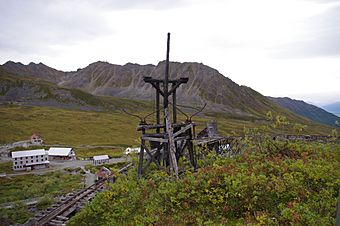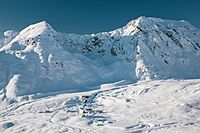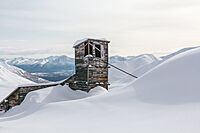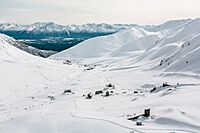Independence Mines, Alaska facts for kids
Quick facts for kids |
|
|
Independence Mines
|
|

Remains of the tram and work camp
|
|
| Location | About 14.2 miles (22.9 km) northwest of Palmer, Alaska |
|---|---|
| Area | 75 acres (30 ha) |
| Built | 1934 |
| Built by | Wasilla Mining Company |
| Architect | N. Lester Troast & Associates et al. |
| NRHP reference No. | 74000440 |
| Added to NRHP | October 9, 1974 |
The Independence Mines, now known as Independence Mine State Historic Park, is a cool place in the Talkeetna Mountains of Alaska. It used to be a very busy gold mine! Imagine a whole town built just for mining gold. This park is located near Palmer, Alaska, and it's a great spot to learn about Alaska's gold rush history.
Contents
Digging for Gold: A Mine's Story
People started looking for gold here way back in 1897. Miners found gold in a place called Fishook Creek. Over time, many small mining efforts joined together. In 1934, they formed the Wasilla Mining Company. This company worked hard to find gold until 1943. They also mined again from 1948 to 1950.
The Independence Mine was a really big deal. It was the second-largest hard-rock gold mine in all of Alaska. Only a mine near Juneau was bigger. The company and the miners built a large camp. It had sixteen wooden buildings. These buildings were even connected by covered wooden tunnels!
The Mine's Legacy
When the Wasilla Mining Company stopped working in 1950, they thought they would come back. Because of this, they left a lot of their mining equipment and buildings behind. This is why the site is so well-preserved today. Even though the weather has damaged some buildings, it's still amazing to see.
In 1974, the mining camp was added to the National Register of Historic Places. This means it's a special historical site. Then, in 1980, the land was given to the state of Alaska. That's when it became the Independence Mine State Historic Park.
Later Mining Attempts
In 1979, a company called Coronado Mining Inc. tried to mine gold again. They wanted to process the gold on the Willow side of the mountain. The Independence Gold Mine has produced over 165,500 ounces of gold in its history. That's a lot of gold!
Coronado Mining worked on the mine in the early 1980s. They explored underground and found more gold ore. The gold was found in quartz veins. These veins also contained other minerals like pyrite and galena. They built a mill to process the ore. The mill was dedicated in August 1982. However, Coronado stopped operations in November 1982. They had problems getting all the gold out of the ore.
Climate at the Mine
Independence Mine State Historic Park has a tundra climate. This means it's usually very cold and dry. The ground can be frozen for much of the year.
| Climate data for Independence Mine, Alaska, 2006–2020 normals, 1998-2020 extremes: 3550ft (1082m) | |||||||||||||
|---|---|---|---|---|---|---|---|---|---|---|---|---|---|
| Month | Jan | Feb | Mar | Apr | May | Jun | Jul | Aug | Sep | Oct | Nov | Dec | Year |
| Record high °F (°C) | 49 (9) |
46 (8) |
52 (11) |
63 (17) |
64 (18) |
73 (23) |
77 (25) |
68 (20) |
63 (17) |
53 (12) |
48 (9) |
44 (7) |
77 (25) |
| Mean maximum °F (°C) | 37 (3) |
38 (3) |
41 (5) |
48 (9) |
56 (13) |
62 (17) |
65 (18) |
62 (17) |
55 (13) |
46 (8) |
39 (4) |
37 (3) |
65 (18) |
| Mean daily maximum °F (°C) | 22.7 (−5.2) |
24.5 (−4.2) |
27.3 (−2.6) |
37.1 (2.8) |
44.9 (7.2) |
49.8 (9.9) |
53.9 (12.2) |
51.6 (10.9) |
44.9 (7.2) |
35.4 (1.9) |
25.7 (−3.5) |
24.7 (−4.1) |
36.9 (2.7) |
| Daily mean °F (°C) | 18.1 (−7.7) |
19.5 (−6.9) |
20.8 (−6.2) |
29.8 (−1.2) |
39.0 (3.9) |
44.4 (6.9) |
49.4 (9.7) |
47.2 (8.4) |
40.6 (4.8) |
31.0 (−0.6) |
21.1 (−6.1) |
20.1 (−6.6) |
31.8 (−0.1) |
| Mean daily minimum °F (°C) | 13.1 (−10.5) |
14.5 (−9.7) |
14.0 (−10.0) |
22.6 (−5.2) |
33.0 (0.6) |
39.1 (3.9) |
44.8 (7.1) |
42.9 (6.1) |
36.2 (2.3) |
26.7 (−2.9) |
16.9 (−8.4) |
15.5 (−9.2) |
26.6 (−3.0) |
| Mean minimum °F (°C) | −6 (−21) |
−2 (−19) |
−1 (−18) |
10 (−12) |
24 (−4) |
32 (0) |
38 (3) |
36 (2) |
27 (−3) |
13 (−11) |
1 (−17) |
−1 (−18) |
−6 (−21) |
| Record low °F (°C) | −20 (−29) |
−20 (−29) |
−13 (−25) |
−6 (−21) |
15 (−9) |
28 (−2) |
33 (1) |
30 (−1) |
21 (−6) |
0 (−18) |
−9 (−23) |
−14 (−26) |
−20 (−29) |
| Average precipitation inches (mm) | 2.69 (68) |
2.62 (67) |
2.33 (59) |
2.09 (53) |
2.24 (57) |
3.12 (79) |
4.79 (122) |
6.48 (165) |
6.49 (165) |
3.98 (101) |
2.73 (69) |
2.85 (72) |
42.41 (1,077) |
| Source 1: XMACIS2 | |||||||||||||
| Source 2: NOAA (Precipitation) | |||||||||||||





